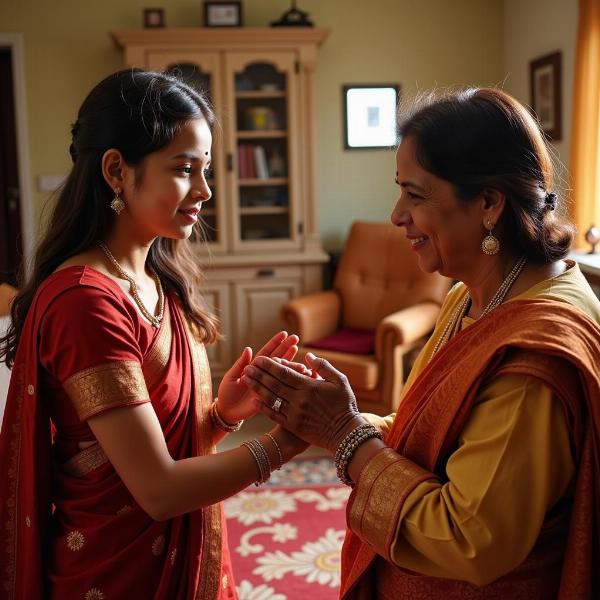Understanding the nuances of expressing respect in Hindi is crucial for navigating social and professional interactions in India. “Huge respect meaning in Hindi” encompasses a spectrum of emotions, from simple courtesy to deep veneration. This article explores various ways to convey huge respect in Hindi, delving into cultural context, appropriate situations, and the subtle power of language.
Showing Respect Through Hindi Words and Phrases
Hindi, like many Indian languages, offers a rich vocabulary for expressing respect. Beyond the commonly used “kripya” (please) and “dhanyavaad” (thank you), several expressions convey deeper admiration. Choosing the right words can significantly impact how your respect is perceived.
-
“Aadar” (आदर): This versatile term embodies respect and regard. You might use it to address elders or figures of authority. For instance, “Mai aapka aadar karta hun” (मैं आपका आदर करता हूँ) translates to “I respect you.”
-
“Samman” (सम्मान): “Samman” denotes a high level of respect, often associated with honour and dignity. “Main aapka samman karta hun” (मैं आपका सम्मान करता हूँ) conveys deep respect and is suitable for addressing esteemed individuals.
-
“Shraddha” (श्रद्धा): This word signifies reverence and devotion, often used in religious contexts. However, it can also express profound respect for someone’s wisdom or character.
-
“Pranaam” (प्रणाम): A common greeting, “pranaam” is a respectful gesture accompanied by a slight bow. It’s a versatile way to show respect regardless of age or social standing.
 Showing Respect in Indian Culture
Showing Respect in Indian Culture
Cultural Significance of Respect in India
Respect is deeply ingrained in Indian culture, influencing social interactions, family dynamics, and even professional relationships. Understanding this cultural context is crucial to effectively conveying “huge respect” in any situation.
-
Respect for Elders: Elders hold a revered position in Indian society. Addressing them with respectful terms and gestures is considered essential. This includes using plural pronouns like “aap” (आप) instead of singular “tu” (तू).
-
Guru-Shishya Parampara: The traditional teacher-student relationship (Guru-Shishya Parampara) emphasizes utmost respect for the guru (teacher). This deep respect stems from the belief that the guru imparts not just knowledge, but also wisdom and guidance for life.
Communicating Huge Respect Beyond Words
While words are essential, non-verbal cues play a significant role in expressing respect in India. Body language, tone of voice, and even attire can convey your level of regard.
-
Body Language: Maintaining eye contact (respectfully, not staring), offering a slight bow, and using gestures like joining hands (Namaste) demonstrate respect.
-
Tone of Voice: Speaking in a calm and respectful tone enhances the impact of your words. Avoiding slang and using formal language further strengthens the expression of respect.
Huge Respect in Professional Settings
In the Indian workplace, demonstrating respect for superiors and colleagues is crucial for building positive relationships. Addressing individuals with their appropriate titles and showing deference to their experience and expertise fosters a harmonious work environment.
Conclusion: Navigating the Nuances of Respect
Expressing “huge respect meaning in Hindi” goes beyond simple translations. It involves understanding the cultural context, choosing appropriate words and phrases, and using respectful body language. By embracing these nuances, you can effectively communicate your admiration and build stronger relationships in both personal and professional spheres. Remember, genuine respect, communicated sincerely, transcends language barriers and fosters deeper connections.
FAQ
-
What is the most common way to show respect in India? Greeting someone with “Namaste” (नमस्ते) with folded hands is a common and respectful gesture.
-
Is it important to use formal language when expressing respect in Hindi? Yes, using formal language, especially when addressing elders or superiors, demonstrates respect and politeness.
-
Are there different ways to express respect based on gender? While the core principles of respect remain consistent, certain terms and gestures might be more appropriate depending on the gender and relationship dynamics.
-
How can I show respect to someone I don’t know well? Using polite phrases like “kripya” (कृपया) and “dhanyavaad” (धन्यवाद) and maintaining respectful body language is a good starting point.
-
What should I avoid doing when trying to show respect in India? Avoid using slang, interrupting others while they are speaking, and pointing your feet directly at someone.
-
What are some other ways to express gratitude besides “dhanyavaad”? You can also say “shukriya” (शुक्रिया) which is another common way to express gratitude.
-
How do I address someone much older than me respectfully? Using respectful terms like “ji” (जी) after their name and using plural pronouns (“aap”) shows respect.
mahaj meaning in hindi
quite a few meaning in hindi
i am big fan for you meaning in hindi
traffic jam meaning in hindi
Meaning-Hindi.in is your trusted partner for accurate and culturally sensitive Hindi translation services. We specialize in a wide range of translation needs, from business and legal documents to technical manuals and website localization. Our team of expert linguists ensures that your message is conveyed effectively while respecting cultural nuances. Contact us today for a free quote! Email: [email protected], Phone: +91 11-4502-7584. Let Meaning-Hindi.in bridge the language gap for you.